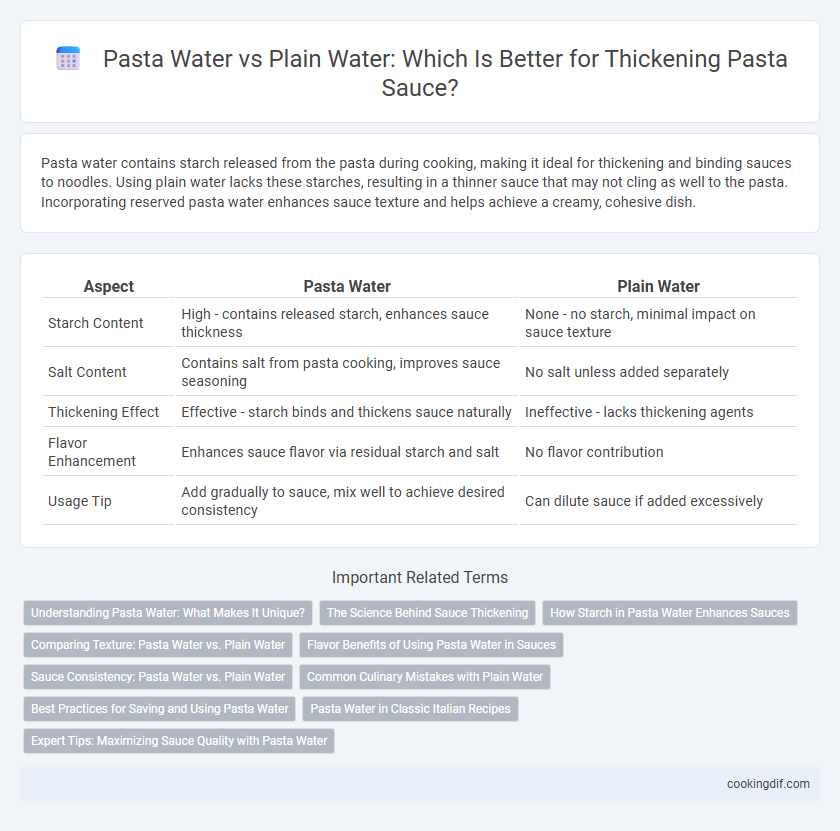Pasta water contains starch released from the pasta during cooking, making it ideal for thickening and binding sauces to noodles. Using plain water lacks these starches, resulting in a thinner sauce that may not cling as well to the pasta. Incorporating reserved pasta water enhances sauce texture and helps achieve a creamy, cohesive dish.
Table of Comparison
| Aspect | Pasta Water | Plain Water |
|---|---|---|
| Starch Content | High - contains released starch, enhances sauce thickness | None - no starch, minimal impact on sauce texture |
| Salt Content | Contains salt from pasta cooking, improves sauce seasoning | No salt unless added separately |
| Thickening Effect | Effective - starch binds and thickens sauce naturally | Ineffective - lacks thickening agents |
| Flavor Enhancement | Enhances sauce flavor via residual starch and salt | No flavor contribution |
| Usage Tip | Add gradually to sauce, mix well to achieve desired consistency | Can dilute sauce if added excessively |
Understanding Pasta Water: What Makes It Unique?
Pasta water contains starch released from the pasta during cooking, which acts as a natural thickening agent for sauces, enhancing their texture and helping them cling better to the pasta. Unlike plain water, pasta water's starchy consistency provides a silky, glossy finish, making sauces richer and more cohesive. The minerals and salt absorbed during boiling also contribute to flavor balance and improved sauce emulsification.
The Science Behind Sauce Thickening
Pasta water contains starch released from the pasta during cooking, which acts as a natural thickening agent when added to sauces, creating a smoother and creamier texture. The starch molecules bind with the liquid in the sauce, enhancing viscosity and helping the sauce adhere better to the pasta. Using plain water lacks these starches, resulting in thinner sauces that do not cling as effectively.
How Starch in Pasta Water Enhances Sauces
Starch in pasta water acts as a natural thickening agent by releasing amylose and amylopectin during cooking, which bind with the sauce to create a smoother, creamier texture. This starchy water improves sauce adhesion on pasta, preventing separation and enhancing flavor infusion. Using pasta water instead of plain water retains the perfect consistency and mouthfeel in sauces like Alfredo or carbonara.
Comparing Texture: Pasta Water vs. Plain Water
Pasta water contains starch released from the pasta during cooking, making it ideal for thickening sauces and creating a smooth, velvety texture that clings well to the noodles. Plain water lacks these starches, resulting in thinner sauces that fail to bind effectively, often causing the sauce to slip off the pasta. Utilizing pasta water enriches sauce consistency, enhancing both mouthfeel and flavor integration in pasta dishes.
Flavor Benefits of Using Pasta Water in Sauces
Pasta water contains starch released from the pasta surface, which enhances sauce thickness and improves its ability to cling to noodles, resulting in a richer texture. The residual salt and flavor compounds inherent in pasta water amplify the sauce's savory profile, deepening umami notes and overall taste complexity. Using pasta water instead of plain water ensures better emulsification of oils and ingredients, creating a cohesive and flavorful sauce experience.
Sauce Consistency: Pasta Water vs. Plain Water
Pasta water contains starch released from the pasta during cooking, which helps create a smoother, silkier sauce with better adhesion to the noodles, enhancing overall sauce consistency. Plain water lacks these starches, resulting in a thinner, less cohesive sauce that may not cling as effectively to the pasta. Incorporating reserved pasta water into the sauce boosts thickness and texture, making it a preferred choice for chefs aiming for a perfect sauce finish.
Common Culinary Mistakes with Plain Water
Using plain water instead of pasta water for sauce thickening often results in a lack of flavor and poor sauce adhesion, as pasta water contains starch that acts as a natural emulsifier. Common culinary mistakes include neglecting to reserve pasta water, which helps sauces cling to noodles and enhances texture through starch content. Incorporating pasta water improves sauce consistency and prevents separation, transforming simple sauces into rich, flavorful coatings.
Best Practices for Saving and Using Pasta Water
Pasta water contains starch released during cooking, making it ideal for thickening and enriching sauces compared to plain water. Best practices for saving pasta water include reserving a cup before draining and gradually adding it to the sauce to achieve the desired consistency without thinning. Using warm pasta water helps emulsify the sauce, enhancing texture and flavor while ensuring the sauce clings effectively to the pasta.
Pasta Water in Classic Italian Recipes
Pasta water contains starch released from the pasta during cooking, making it an essential ingredient for thickening and emulsifying sauces in classic Italian recipes. The starchy, slightly salty water helps achieve a smooth, clingy texture that plain water cannot replicate. Incorporating pasta water enhances the sauce's consistency and flavor, allowing it to adhere perfectly to the pasta.
Expert Tips: Maximizing Sauce Quality with Pasta Water
Pasta water contains starch released during cooking, which serves as a natural thickener and emulsifier, enhancing sauce texture and consistency. Experts recommend reserving a cup of this starchy water to gradually incorporate into sauces, achieving optimal creaminess without dilution. Using pasta water instead of plain water improves sauce adhesion and flavor integration, resulting in a richer and more cohesive dish.
pasta water vs plain water for sauce thickening Infographic

 cookingdif.com
cookingdif.com